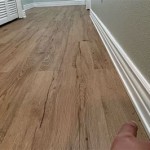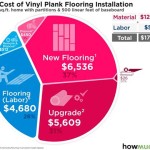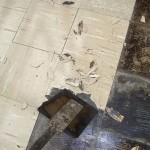Laminate Flooring Vapor Barrier: Necessity and Implementation
Laminate flooring is a popular choice for residential and commercial spaces due to its durability, affordability, and aesthetic versatility. However, successful and long-lasting laminate flooring installations require careful consideration of various underlying factors, one of the most critical being moisture management. Implementing a vapor barrier beneath laminate flooring is a common practice, but the necessity and effectiveness of this practice warrant thorough examination.
The purpose of a vapor barrier, also frequently referred to as a moisture barrier or vapor retarder, is to impede the transmission of moisture vapor from the subfloor into the laminate flooring. Subfloors, typically constructed of concrete or wood, can be sources of moisture due to ground moisture, condensation, or spills. Excessive moisture can have detrimental effects on laminate flooring, leading to warping, buckling, mold growth, and ultimately, structural failure. Therefore, the decision to install a vapor barrier is a crucial one that impacts the longevity and performance of the flooring system.
The prevailing environmental conditions, the type of subfloor, and the characteristics of the laminate flooring itself all influence the need for a vapor barrier. Some laminate flooring products come with an attached underlayment that includes a vapor barrier, while others require a separate installation. Understanding these nuances is essential for making an informed decision.
Understanding the Role of Vapor Barriers in Moisture Management
Vapor barriers function by reducing the rate at which water vapor diffuses through a material. They are not designed to completely block moisture, but rather to slow its movement. The effectiveness of a vapor barrier is measured by its permeance rating, which indicates how easily moisture vapor can pass through the material. Lower permeance values indicate a more effective vapor barrier.
In the context of laminate flooring, a vapor barrier is strategically placed between the subfloor and the laminate to prevent moisture originating from the subfloor from reaching the flooring material. This is particularly important in situations where the subfloor is concrete, as concrete can absorb moisture from the ground. Wood subfloors, while less porous than concrete, can still be susceptible to moisture issues due to leaks, high humidity, or inadequate ventilation.
The vapor barrier also helps to protect the laminate flooring from spills or accidents that might occur on the surface. While laminate is water-resistant to some extent, prolonged exposure to moisture can cause damage. The vapor barrier can provide an additional layer of protection, preventing water from seeping into the subfloor and causing further problems.
It's important to note the distinction between a vapor barrier and a moisture barrier. While the terms are often used interchangeably, a vapor barrier is generally understood to be a material with a very low permeance rating, effectively blocking almost all moisture vapor transmission. A moisture barrier, on the other hand, has a slightly higher permeance rating and allows for some level of moisture vapor transmission. In most laminate flooring applications, a vapor barrier is the preferred choice.
Factors Influencing the Necessity of a Vapor Barrier
Several factors determine whether a vapor barrier is necessary for a laminate flooring installation. These factors can be broadly categorized into environmental conditions, subfloor type, and laminate flooring specifications.
Environmental Conditions: The climate in which the flooring is installed plays a significant role. In areas with high humidity, a vapor barrier is generally recommended, regardless of the subfloor type. High humidity increases the likelihood of moisture vapor permeating the subfloor and affecting the laminate flooring. Similarly, in areas prone to flooding or water damage, a vapor barrier is essential to protect the flooring from water intrusion.
Subfloor Type: The type of subfloor is a primary determinant of vapor barrier necessity. Concrete subfloors are inherently porous and can wick moisture from the ground. Therefore, a vapor barrier is almost always recommended for laminate flooring installed over concrete. Wood subfloors, while less porous, can still be vulnerable to moisture due to leaks or inadequate ventilation. In such cases, a vapor barrier may be necessary.
Laminate Flooring Specifications: Some laminate flooring products come with an attached underlayment that includes a built-in vapor barrier. In these cases, a separate vapor barrier may not be required, provided that the included vapor barrier meets the required permeance standards. It is crucial to consult the manufacturer's specifications to determine whether an additional vapor barrier is necessary. Ignoring the manufacturer's recommendations can void the warranty and lead to flooring issues.
Furthermore, consider the age and condition of the subfloor. Older concrete subfloors may have cracks or imperfections that allow for greater moisture penetration. Similarly, wood subfloors that have been previously exposed to water damage may be more susceptible to moisture issues. In such cases, a vapor barrier is even more critical.
Another factor to consider is the presence of a crawl space beneath the flooring. If the crawl space is unventilated or has a dirt floor, it can be a significant source of moisture. In these situations, a vapor barrier is highly recommended, even if the subfloor is wood.
Proper Installation Techniques for Vapor Barriers
Even the best vapor barrier will be ineffective if not installed correctly. Proper installation techniques are crucial to ensure that the vapor barrier provides adequate protection against moisture vapor transmission.
Before installing the vapor barrier, the subfloor should be thoroughly cleaned and leveled. Any debris or unevenness can create gaps or punctures in the vapor barrier, compromising its effectiveness. Cracks in concrete subfloors should be filled and sealed to prevent moisture from seeping through.
The vapor barrier should be rolled out over the subfloor, overlapping the seams by at least six inches. The seams should then be taped with a moisture-resistant tape to create a continuous barrier. It is essential to use a tape specifically designed for vapor barriers to ensure a proper seal. Ordinary duct tape may not provide adequate adhesion and moisture resistance.
The vapor barrier should also be extended up the walls by a few inches and taped to the wall to prevent moisture from wicking up from the edges. This is particularly important in areas where the flooring meets a wall or baseboard.
When installing laminate flooring over the vapor barrier, care should be taken not to puncture or damage the barrier. Heavy furniture or equipment should be moved carefully to avoid tearing the vapor barrier. If any punctures or tears occur, they should be repaired immediately with moisture-resistant tape.
Finally, it is essential to follow the manufacturer's instructions for both the vapor barrier and the laminate flooring. The manufacturer's recommended installation procedures will ensure that the flooring system is installed correctly and that the warranty is valid.
In conclusion, the decision to install a vapor barrier beneath laminate flooring is a complex one that depends on various factors. Understanding the role of vapor barriers in moisture management, considering the environmental conditions, subfloor type, and laminate flooring specifications, and employing proper installation techniques are all crucial steps in ensuring a successful and long-lasting laminate flooring installation.
While the upfront cost of a vapor barrier might seem like an unnecessary expense, it is a relatively small investment compared to the potential cost of repairing or replacing damaged laminate flooring. By taking the time to assess the need for a vapor barrier and installing it correctly, homeowners and contractors can protect their investment and ensure that their laminate flooring remains beautiful and functional for years to come.
Failing to properly address moisture concerns can lead to a host of problems, including mold growth, which can pose serious health risks. Mold thrives in damp environments and can cause respiratory problems, allergies, and other health issues. By installing a vapor barrier, homeowners can help to prevent mold growth and create a healthier indoor environment.
Ultimately, the decision of whether or not to use a vapor barrier is a risk assessment. Carefully evaluating the factors outlined above will allow for an informed decision that protects the laminate flooring investment and contributes to a healthier living environment.

What Is A Moisture Barrier And When It Needed For Flooring Inc

What Is A Moisture Barrier And When It Needed For Flooring Inc

When Underlayment Is Not Necessary For Laminate Flooring Mp Global S Llc

What Is A Moisture Barrier And When It Needed For Flooring Inc

Vinyl Flooring Does It Need Underlayment Word Of Mouth Floors

10 Critical Reasons Why You Need A Below Slab Vapor Barrier

6 Mil Vapor Barrier Underlayment Over Concrete Floors

Best Luxury Vinyl Flooring Allfloors Trade Centre

Best Luxury Vinyl Flooring Allfloors Trade Centre
Minimizing Moisture From Subflooring Kaltimber Timber Merchant Flooring
Related Posts








